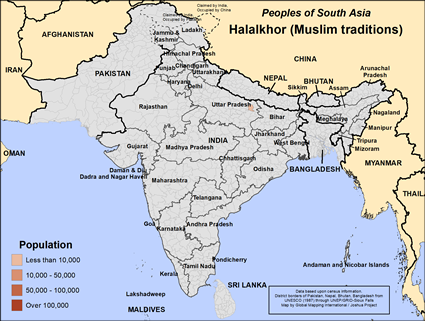Halalkhor (Muslim traditions) in India

Send Joshua Project a photo
of this people group. |

Map Source:
People Group data: Omid. Map geography: UNESCO / GMI. Map Design: Joshua Project
|
| People Name: | Halalkhor (Muslim traditions) |
| Country: | India |
| 10/40 Window: | Yes |
| Population: | 3,700 |
| World Population: | 3,700 |
| Primary Language: | Hindi |
| Primary Religion: | Islam |
| Christian Adherents: | 0.00 % |
| Evangelicals: | 0.00 % |
| Scripture: | Complete Bible |
| Ministry Resources: | Yes |
| Jesus Film: | Yes |
| Audio Recordings: | Yes |
| People Cluster: | South Asia Muslim - other |
| Affinity Bloc: | South Asian Peoples |
| Progress Level: |
|
Introduction / History
Their name comes from two words:halal and khor meaning "those who eat halal food." The Halalkhor people are descendants of the Hindu Bhangi people who converted to Islam. The Halalkor people have low status. They are trying to gain scheduled caste status which is a large step higher. This is not likely to happen because they are not Hindus. They live in Uttar Pradesh and Bihar. In Uttar Pradesh they speak many dialects of Hindi.
What Are Their Lives Like?
The Halhalkhor are sweepers and scavengers by tradition. This gives them very low status. In Bihar the Halalkhor are sweepers and they speak in several dialects. Many have migrated to other parts of India and work as day laborers. The Halhalkhor have caste councils who judge their community disputes.
What Are Their Beliefs?
There are both Shia and Sunni Muslims among them and these two groups intermarry, which is unusual anywhere in the world. They fear and serve Allah who does not provide payment of the penalty for their sins and will never ensure them eternal life.
What Are Their Needs?
They need to find their worth and dignity through a relationship with Jesus Christ.
Prayer Points
Pray that God will give the Halhalkhor people dreams and visions leading them put their trust in the only Savior.
Pray that they will find their dignity and worth in Jesus.
Pray that they will soon find their way out of poverty and misery. Pray for intercessors and workers among them.